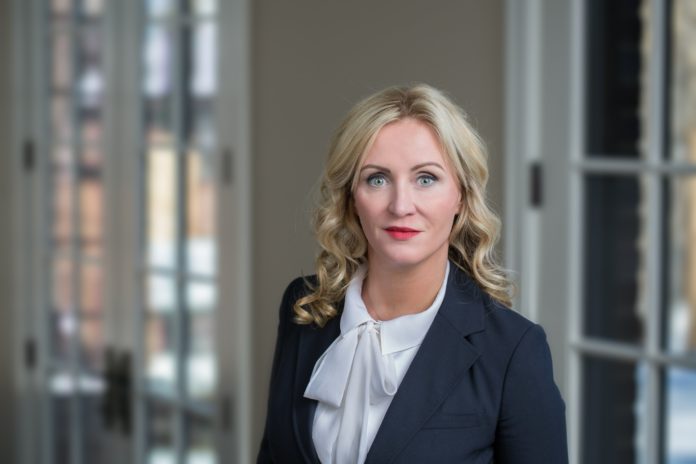The experience of medical patients across the nation may vary depending on a number of factors, and whether you’re seeking routine care, emergency services, or a host of other items, one thing remains the same: the healthcare system that we all must work within is complex at best. When it comes to the way services are coded and billed along with the ins and outs of insurance payments, it’s no small feat to understand the processes that are currently in place. Only an individual with years of time and attention spent on the ground level of healthcare facilities would even begin to grasp such a system, and for one woman, her experience has allowed her to transition into a role that makes these elements much easier to handle.
Deirdre Baggot, Ph.D., MBA, RN has worked with a vast range of healthcare organizations over the last two decades in various roles, placing her in a position to deeply absorb the ways in which costs can be lowered while simultaneously improving upon patient care and streamlining facility procedures. As the nation’s healthcare landscape continues to undergo complex changes, Deirdre has been at the forefront of the industry, acting as a resource for those who need assistance in managing all of the options ahead of them.

Not only has she been instrumental in forging the way for bundled payment systems and assisting facilities throughout the application process while creating accurate expectations for the transition, but she takes on a larger role within healthcare business strategy as a whole, walking the fine line between patient advocate and organizational resource. Having authored over 20 papers on bundled payment systems alone and working side by side with more than 200 hospitals to design operational procedures that meet multiple demands, Baggot blends a personal touch with her approach to partnership, making her one of the most sought-after individuals within the healthcare world.
Let’s take a closer look at the areas in which Deirdre has made an impact in the industry, how she views the future of the healthcare field, and the knowledge that she imparts into each of her clients that she so diligently serves.
Understanding The Landscape
It’s one thing to mention the phrase bundled payment system and have a loose understanding of the term, but actually implementing this strategy into a complex healthcare organization is quite another task. Sometimes a bit of history is helpful when attempting to determine the future, and in this case, our nation’s long and ever-changing relationship with healthcare professionals, insurance providers, and more has created a melting pot of information.
As it stands, many of America’s healthcare providers are still utilizing a fee-for-service model that attempts to match up services with dollars as best as it can. While most people are used to visiting any number of physicians, whether it be for a routine annual exam or emergency surgery, it has become commonplace to expect billing to follow this model. In a sense, it makes a logical argument that for each test or procedure rendered, an appropriate fee would be assessed.
However, since the start of the Affordable Care Act in 2010, the efforts of legislators to move away from this program have mostly gone unnoticed. Estimates show that between 86% and 95% of doctors in the nation are still using a fee-for-service system, and it’s been equated to an addiction within the medical community. Why? Because the more services you can offer, the more money you can collect. While it’s certainly not fair to say that providers across the nation do this without a second thought, there are some out there who surely take advantage of the system.
Some may say it’s an anomaly to overcode a patient’s visit and create charges for services that aren’t really necessary in the attempt to pad one’s bottom line, but this practice has created a much larger issue that’s become systemic of organizations everywhere. One of the main components that Baggot addresses when she works with clients is to improve upon the patient experience, and understanding that repeat testing, unnecessary services, and a host of billing errors have greatly diminished how patients perceive their medical care is an important connection.
When the standard of care has become one that attempts to nickel and dime patients using the fee-for-service model, it becomes painfully clear that something needs to be altered. While a bundled payment system isn’t the fit for every healthcare organization out there, the benefits they bring to practices both large and small often help to increase revenues while boosting overall patient experiences, something that current methodologies are falling short of.
How Bundled Payments Can Help
Imagine how a physician may approach his or her workday, knowing that there are a wealth of patients who will be passing through the office doors. Time and money tend to be the driving factors for so many organizations nationwide, and it’s up to each individual doctor to maximize on both. Using a fee-for-service model, patient visits are kept to a minimum, and any number of tests or procedures could be utilized in an effort to provide adequate care while also looking out for one’s bottom line.
Now examine the system of bundled payments, where organizations are provided one singular payment for an agreed upon set of services. These services are termed an “episode of care” and they can range from routine office visits up to complex surgeries. Past models have dictated that each service, and the associated physicians, would receive payment based upon the care they rendered, while bundled payments work a bit differently.
A fee-for-service scenario would dictate that a surgeon, hospital, and anesthesiologist would all receive reimbursements based upon their specific involvement with a given patient. Instead, a bundled payment model would distribute payments based upon pre-determined prices that all factor into the single episode. Not only does this provide a clear financial picture for patients but it also imparts a sense of transparency into the industry, making it much more difficult for certain organizations to overinflate their pricing.
Deirdre Baggot has helped countless healthcare facilities in making the transition from an older model to a method of bundled payments, but she’s careful to urge providers to remember that the grass isn’t always greener on the other side. While bundled payments do bring about an incredible opportunity for change, there are risks that come along with them.
Baggot’s Tips For Transition
The payment framework in any given healthcare organization plays a massive role in its overall state of operations, and whether a small private practice is looking to change their payment model or a multi-location hospital has seen the clear value in bundled payments, there are specific elements to keep in mind. Baggot has partnered with countless organizations to give them a clear picture on what the change away from fee-for-service payments might look like as well as offering suggestions for determining if the new model is right for them:
- Everyone must be on board – While this sounds like a nugget of common sense, it’s surprising just how many organizations attempt to transition over to a bundled payment system without having their key players involved. All personnel, from scheduling staff to nurses and all the way up the ladder to physicians and CEOs, must shift their mindset to the common goal of new and improved patient care. While traditional fee-for-service models dictated specific procedures for initial visits, follow up appointments, and coordinating the continuation of care, all parties must adhere to this new way of working.
One of the key issues that Deirdre often sees in larger organizations is the lack of provider engagement, and in some instances those who have been in the field for decades will have a difficult time during the transition. An entirely new mindset is needed by all, one that focuses more on patient care instead of the bottom line.
- Coordination must be clear – Another hurdle that Baggot often helps organizations to clear is the issue of communication between emergency rooms and post-acute care facilities. Whether it’s due to a mismatch in how each uses EHR systems or simply an issue of high turnover and lack of experience, bundled payment systems leave little room for error. In the past, the instance of ordering multiple tests, sending patients back to the ER unnecessarily, and the issues of having to wait so long for data to close the feedback loop lead to inefficiency and frustrated patients, yet continued to generate revenue for healthcare facilities.
With bundled payments, any sort of misstep of this kind is simply a redundancy that will cost all parties time and energy without any additional compensation. Ensuring that there’s clear communication between larger organizations and post-acute facilities is one of the highest priorities a group can make when transitioning to this new method.
- Reviewing the numbers – Without keeping a close eye on the financial trajectory of an organization, one may never know if a bundled payment system is truly working for the better. Not only do the dollars and cents need to be examined, but Baggot is a strong advocate for healthcare officials to utilize today’s technology to make fact-based decisions.
Information from EHR systems can provide a wealth of knowledge when it comes to services rendered and overall patient care, and the announcement early in 2018 from the Centers for Medicare & Medicaid Services to release Medicare Advantage data will go a long way. Deciding to shift an entire organization’s payment system is a huge undertaking that involves a significant amount of risk, and Deirdre’s expertise can help leaders to interpret the best models of care for their practice.
Looking Toward The Future
With such a huge undertaking as consulting with healthcare organizations to overhaul one of their most crucial systems on her plate, it would be a safe assumption that Deirdre has little time to devote to anything else. As deadlines for enrolling in bundled payment systems have come and gone, there’s no doubt that countless facilities will be looking to her expertise to help them navigate these new waters. However, Baggot has her eye on more than just payment systems, and there’s one healthcare trend that she’s particularly excited about.
The name of the device may change, but the intention is still the same – wearable devices are becoming all the rage in the healthcare industry. Several iterations of these items have been in use for years with more streamlined and versatile options appearing on the horizon to better manage patient care. Wearables can essentially be divided into two categories: personal fitness trackers and medical grade devices.
Brand names aside, the movement to use a tracking device in the attempt to increase daily exercise, count calories, or monitor one’s sleep is just the beginning of the idea that individuals can take healthcare into their own hands. Baggot is particularly excited with this new attitude of engagement, noting that those who are willing to take a more active role in their own health and wellness will pave the way for subsequent positive changes.
Tech companies have certainly thrown their hat in the ring in recent years, partnering with researchers and medical professionals to create devices that work to remotely monitor the health of patients who may be deemed at-risk. Everything from medication compliance to blood sugar monitoring could potentially be tracked via wearable devices, smartphone applications, and even smart pills. Patients who have limited mobility are especially primed to engage with this new wave of technology, allowing physicians to provide more comprehensive care without including the challenges of transportation to and from the office.
Using Deirdre As A Resource
It’s not just the papers she’s authored or the boards she has been a part of over the years; Baggot’s ability to help healthcare organizations to maximize their potential comes from decades of hands-on experience. After receiving her nursing degree from Southern Illinois University, Edwardsville, she dove headfirst into the field at Northwestern Memorial Hospital. Joining the team in 1997, she worked as a staff nurse and resource coordinator before moving up the ranks to manage the hospital administration group.
Six years after her start at Northwestern, Deirdre moved to the University of Michigan Health System, taking on the role as their business analyst and an administrative manager. Drawing upon her experience with patients and seeing how the actions of the floor staff directly affect the inner workings of the organization, she began to define clear links between the two and worked to develop her consulting methodologies.
Deirdre’s success continued in Denver, Colorado where she partnered with a group of more than 450 individuals, and after helping them to see monumental results, she accepted a role in Los Angeles, California as one of the senior vice presidents at GE Healthcare Partners. Her experience in payment systems was put to the test here, and she was able to produce revenue that numbered more than $6 million when all was said and done.
Many organizations look to Baggot’s involvement at Exempla Healthcare around the CMS Acute Care Episode bundled payment system and firmly acknowledged that she is one of the premier thought leaders in the industry when it comes to this complex subject. Also having served as an Expert Reviewer to the Centers for Medicare & Medicaid Services, her ability to identify potential risks and opportunities within any given organization has played a monumental role in her ability to advise healthcare organizations of all sizes.
As the time for bundled payments to go into effect is drawing near, Deirdre will no doubt have a plethora of organizations looking to her for guidance. She worked with clients until the midnight deadline on August 8, 2018 to enroll in the Bundled Payment for Care Initiative Advanced program, and when the full BPCI-A plan begins in March of 2019, she’ll be able to help these early adopters to get started on the right foot.
Healthcare facilities who are interested in utilizing bundled payments rather than a fee-for-service based model that did not meet the August deadline are not left high and dry, as this date served as a trial period with less risk involved. Even if March is too close of a timeline to accurately identify whether this transition is appropriate, another chance in January of 2020 will become available.
It’s only natural that the transition away from a decades-old model comes with a great deal of uncertainty, and organizations who are making their way through this change shouldn’t go it alone. Deirdre Baggot’s consulting assistance is available for any providers who need help addressing key issues including data interpretation, risk assessment, communication issues, best practices, and more. Although the change may be a difficult one at first, Baggot notes that facilities should give an adequate amount of time to fully assess the benefits of a bundled payment program before switching back to a model that initially feels more comfortable. In the end, the benefits of improved patient care, transparent pricing and reimbursements, and the ability to transform the landscape of the healthcare industry one organization at a time are all well worth the growing pains.












